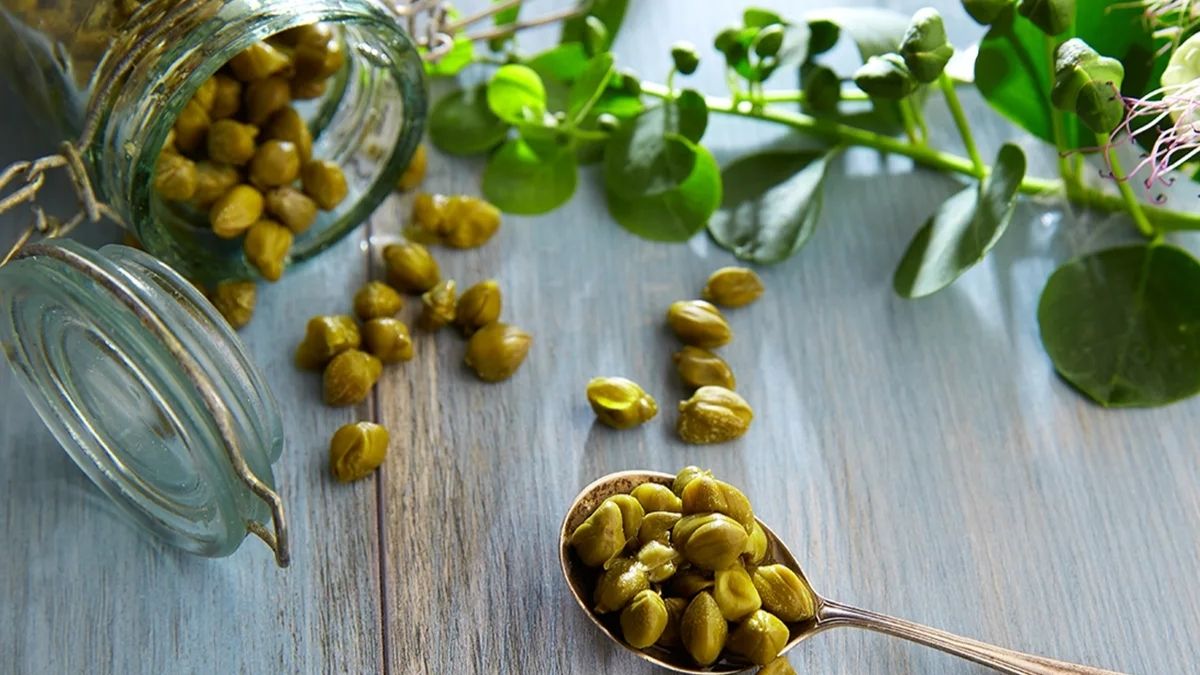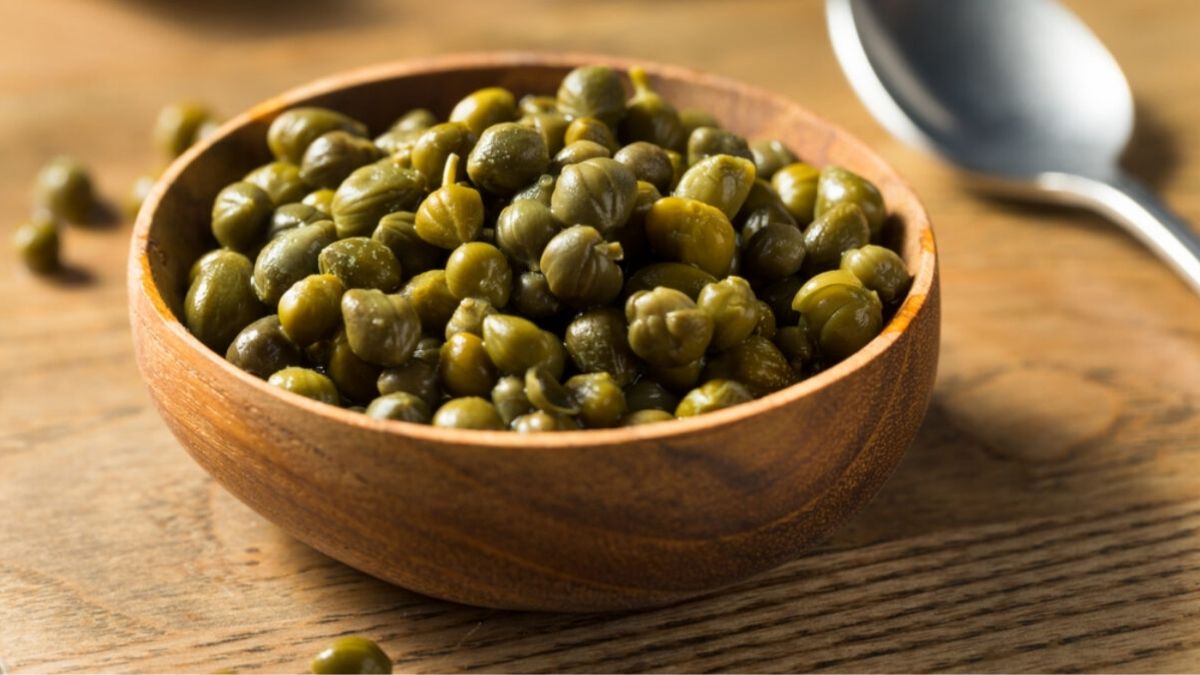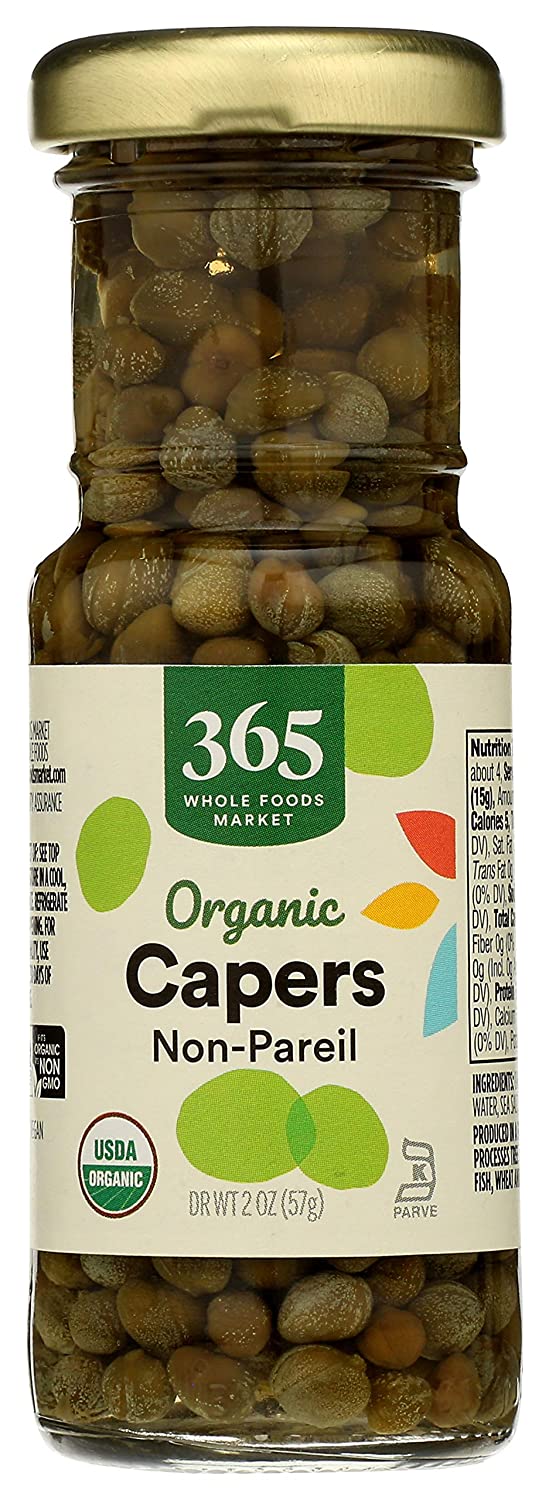Capers are the caper bush’s immature, unripened green flower buds (Capparis spinosa or Capparis inermis). Italy, Morocco, and Spain, as well as Asia and Australia, grow the plant. It’s most commonly linked with Mediterranean cuisine, but it’s popular worldwide. Whether brined or dried, the caper is prized for the explosion of flavor it adds to recipes. It can give texture and tanginess to a wide range of meals, including seafood, pasta, stews, and sauces.
Capers are a low-calorie item, but they don’t provide much nutritional benefit because they aren’t consumed in large numbers. They do, however, contain minerals like vitamins A, E, and K, as well as copper, iron, and magnesium. If you’re limiting your sodium consumption, use capers sparingly because they’re packed in brine and prepared with salt.
What are Capers?
The caper is a thorny perennial plant that grows wild throughout the Mediterranean and Asia. Its use can be traced back to 2,000 B.C. when referenced in the Sumerian Epic of Gilgamesh as a meal. The unripened blossom is dried in the sun before being pickled in vinegar, brine, wine, or salt to make the salty green pea-sized ball. The tart lemon-like flavor, which is akin to green olives, is brought out by curing.
Capers are harvested from a thorny bush known as Capparis spinosa, which grows wild throughout the Mediterranean and portions of Asia. Capers are the plant’s unripened green blossom buds, which we see in the grocery store. The immature buds are harvested, dried, and then stored. Capers are either cured in salt or pickled in brine, which gives them their distinctive savory, salty flavor.
Caper vs. Caperberry
The caper is distinct from the caperberry, and the immature bud eventually grows into the caperberry fruit if it is not picked. The fruit is about the size of an olive and is linked to a long, cherry-like stem, making it more significant than the enormous caper. Caperberries contain tiny seeds that resemble kiwi seeds, and they provide a fascinating garnish for bloody mary cocktails and martinis when pickled.
What are the Varieties of Caper?
Commercial capers are labeled and sold according to their size. The buds range in size from a small pea (around the size of a newborn petite green pea) to a small olive. The smallest caper, in general, has the most delicate texture and flavor. Because an enormous caper is more acidic, it’s preferable to use it sparingly.
The tiniest kind comes from the south of France and measures around 1/4-inch (7mm) in diameter. They’re known as French nonpareils, and they’re the most valuable, with a price tag to match. Slightly larger surfing capers are also relatively easy to come by (7mm to 8mm). Less prevalent are capucines (8mm to 9mm), capotes (9mm to 11mm), fines (11mm to 13mm), and grusas (above 14mm).
What are the Uses of Caper?
Capers have long been a popular condiment in the Mediterranean. They’re famous in Italy for being a key component in dishes like chicken piccata and pasta puttanesca. They’re used in skate Meunier with browned butter in France, and they’re a crucial ingredient in a variety of Spanish tapas. The plant’s fruits and buds are pickled in India. They’re commonly used to garnish and add acid to a New York-style bagel with nova lox and cream cheese in the United States.
Many other recipes benefit from these tiny green buds’ intense sour and salty flavor. They can be added to salads (including pasta, chicken, and potato salads), used as a condiment or garnish, or finely diced for dressings and sauces with little preparation. They’re also used as a pizza topping or cooked with roasted veggies and main dishes. The burst of salt and acid complements seafood, wealthy ones like salmon and lamb. Capers are frequently combined with lemon, which enhances their inherent lemon-olive flavor. Other common accompaniments include cheese and almonds.
Capers
How to Cook with Capers?
Capers should be used sparingly due to their intense flavor (particularly the larger ones). Instead of adding a handful, establish a balance in the recipe to avoid overpowering the flavors of the finished dish.
Capers can be used right out of the jar. Many recipes ask for rinsing the capers to remove some of the salt or vinegar, allowing the caper’s genuine taste to shine. After rinsing the caper, pat it dry with a paper towel. More giant capers should be cut before being used. Some recipes call for finely chopped capers, such as sauces, while others utilize them in a puree, such as tapenade. Most of the time, you’ll combine them with other ingredients in a hot skillet near the finish of the cooking process. This preserves the form of the capers as well as their distinct flavor.
What does Caper Taste Like?
Capers have a lemony, olivey, and salty flavor, and the packaging contributes a lot to the salty, vinegary flavor. They have a flavor similar to green olives’ lemony sharpness and brininess but with a flowery tartness. Capers have a solid salty, savory flavor because they’re filled with brine.
Green olives: Because capers have an olive flavor, green olives are a suitable replacement when you don’t have any on hand. Keep in mind that olives aren’t quite as spicy as capers, and they’re also much more significant, so keep that in mind when swapping one for the other.
Where to Buy Capers?
At least one jar of capers should be available at well-stocked grocery stores, supermarkets, and natural food stores. They’re also available in specialty and gourmet food stores and the internet. Capers are usually sold in little jars containing no more than four ounces of vinegar brine, and they’re in the same section as the olives in the pickled foods section. More miniature nonpareil capers are more expensive than more giant capers, while jars of gourmet olives are comparable in price.
Caper bushes grow naturally in their natural habitats, and the buds can be harvested. Because the caper spurge plant (Euphorbia lathyris) has a similar appearance and is poisonous, proper identification is essential. Planting the bush from seeds or cuttings is also an option for backyard gardeners. The plant can handle the heat but is not cold in northern areas and should be overwintered indoors. Harvest the capers to your desired size, then brine the buds to keep them fresh.
How to Store Caper?
Capers can be packed in brine or salt, affecting how they should be preserved; either way, they should be kept in an airtight container. Brine-packed capers should be completely submerged and kept in the refrigerator for nine months. Jars that haven’t been opened can be kept in the pantry. Salt-packed capers can be kept at room temperature for up to six months.
Capers that have developed foul aromas and dark coloration in the jar (in addition to any spices that may be present) have gone wrong and should be destroyed.
Health Benefits of a Caprese
It’s always satisfying to have an authentic Italian meal for lunch or dinner. Still, with more people concerned about their health than ever before, it’s difficult not to wonder if your food is beneficial for you. Almost every food is fine in moderation, but some foods provide unexpected health benefits that you may not be aware of! Let’s look at Caprese, one of the most famous Italian recipes with numerous health benefits.
Health Benefits by Ingredient
Tomatoes, basil, and fresh mozzarella are the three main ingredients of traditional Caprese. Caprese salads, sandwiches, kinds of pasta, and other variations can be found on many menus, but to be labeled a Caprese, each variation must comprise those essential elements. Take a look at the advantages of each component in a Caprese salad, including:
Tomato – Tomatoes are an excellent source of vitamins. Tomatoes provide roughly 40% of your daily vitamin C needs in one dish. You’ll also receive plenty of potassium, vitamin K, and vitamin A. Lycopene is the red pigment that gives tomatoes their distinctive color. Lycopene has been linked to improved heart and vision health.
Basil – Antioxidants, vitamins, and natural essential oils abound in basil. Basil loses some of its nutritious value when dried, but fresh basil should always be used in this case. Antioxidants, vitamins, and oils can help you avoid cancer, diabetes, arthritis, and heart disease.
Mozzarella – When it comes to cheese, you may not consider the health benefits, but you should when it comes to fresh mozzarella that has been little processed. Potassium, iron, sodium, and chloride are all abundant in mozzarella. It also contains 18% of your daily calcium requirements in just one serving! Phosphorus, a mineral that assists your body in utilizing calcium, is another healthy component of mozzarella. Mozzarella is also high in protein. Although traditional Caprese does not include meat, the protein present in mozzarella will keep you feeling full and invigorated until your next meal.
Conclusion
Capers are famous in Mediterranean cuisine, especially seafood dishes like baked fish and pasta sauces like puttanesca. They also provide a salty, savory, lemony flavor to various dishes, including caper classics like chicken piccata. They also provide a tart counterbalance to rich foods like stews, lamb, and cheese. Capers are frequently served with delectable spreads and used to decorate bagels, cream cheese, and lox in the United States. They add a vibrant, salty backbone to tapenades, sauces, dressings, and compound kinds of butter when finely diced. Capers can also be deep-fried for a crunchy garnish.
Because capers have such a bright, salty flavor, substituting them can be difficult, so keep a jar in your cupboard. A 1:1 ratio of finely chopped green olives will suffice if you’re in a hurry. (For example, one tablespoon chopped green olives for one tablespoon capers.) Kalamata olives are also good, but they aren’t as acidic as green olives.



